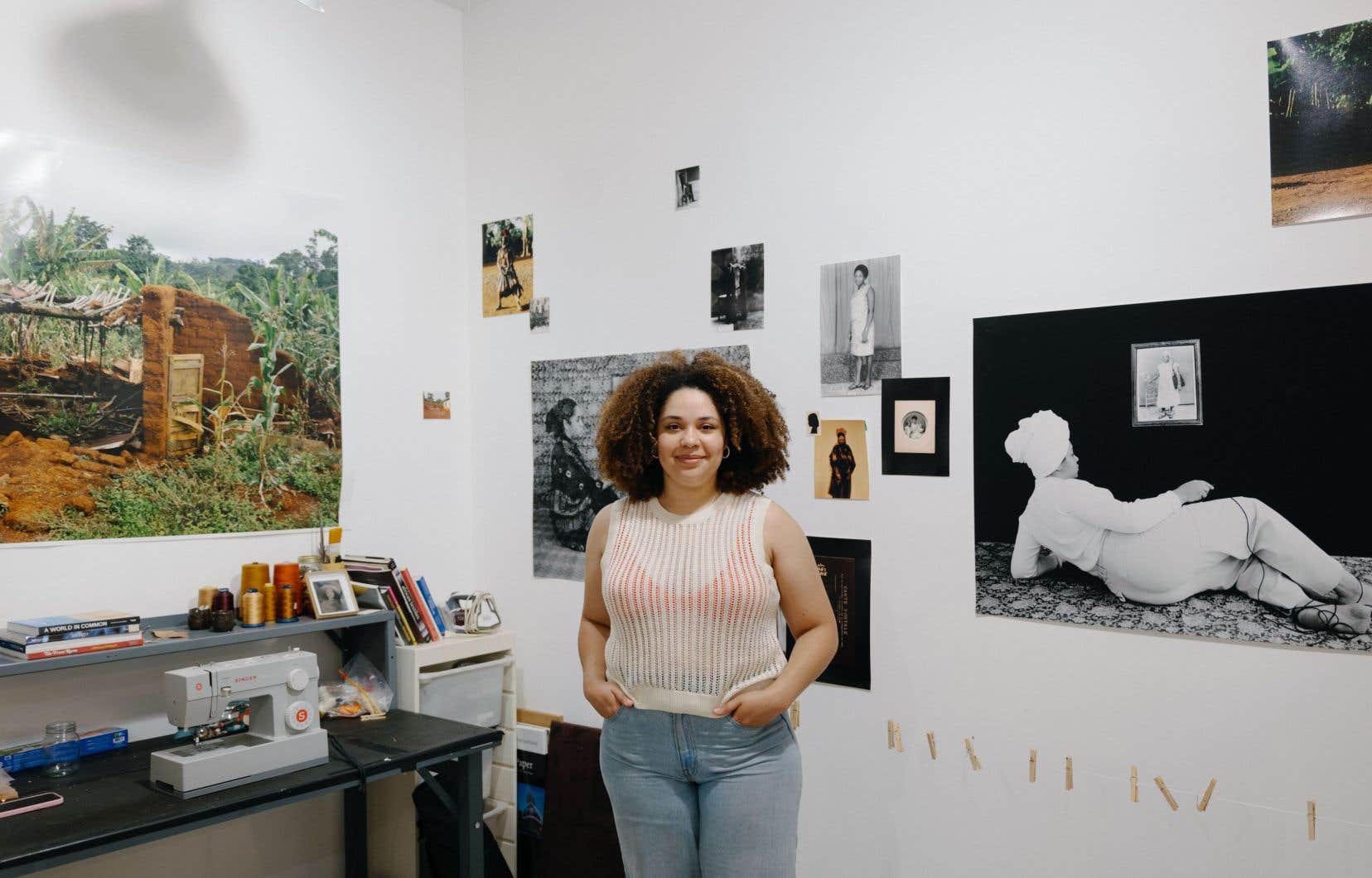To understand how local artists shape matter to extract their vision of the world, you have to go and meet them. Mise en lumière is a series of portraits that appears at the end of each month. Forays into the world of creators who work on their works in an unusual way, away from cultural news.
“What interests me in the history of photography is its colonial past,” confides Mallory Lowe Mpoka, whom we met at the beginning of the summer while she was in residence with Hugues Charbonneau at the Belgo. Because photography is a European invention, the multidisciplinary artist likes to question its ethnographic and anthropological uses, particularly through postcards, in order to format a narrative on non-Western countries that, until now, has often been pejorative and has served to convey stereotypes. “Photography allows us to understand how we visualize the world around us,” she says.
Because of his Cameroonian origins, through his father, and Belgian, through his mother, the artist devotes himself to self-portraits with the aim of reappropriating his history to better “make the world”. “What I love about the photographic studio is that I can put it in my image and transform it as I wish”, explains Mallory Lowe Mpoka. On the walls of his studio, that day, hangs an intriguing series of silver self-portraits taken in 2023. “It is inspired by photographic archives of my paternal grandmother. In one, I am dressed in white, like her when she was a choir leader, and in the other, I am wearing a much more traditional dark outfit”, comments the artist in her mid-twenties.
This work reflects a certain duality and translates an imaginary dialogue, “between my grandmother, myself and my alter ego,” she explains. Looking more closely at the self-portraits, we also realize the presence of tapestries in the decor. “It’s a reference to the rural impressions and floral patterns from my grandmother’s home in Belgium,” says Mallory Lowe Mpoka. Like a cultural intertwining that she embraces through her work.
The power of visual documentation
“In my early twenties, I was questioning my identity and community: Where is my real home?” she asks. Family albums played a key role in understanding her cultural identity. “My mother had kept all the photos of my father’s youth, of when they met, like an archivist,” recalls Mallory Lowe Mpoka of her youth in Montreal, an ocean away from her two families. By regularly reviewing the glossy records of her parents’ and grandparents’ distant existence, she quickly grasped the power of visual documentation. “What intrigued me about this family photo archive was the staging. Often, people were wearing hats and costumes in front of backdrops where the national buildings of Cameroon at the time were painted,” the artist emphasizes. For her, the desire to show themselves as they wished to be perceived illustrates the agency of his ancestors.
Four years ago, in the midst of a pandemic, Mallory Lowe Mpoka found herself in the privacy of the four walls of her room after a trip to Cameroon. “I had been able to bring back a lot of photographs and, by dint of seeing them, being around them, studying them, and being interested in the history of their conception in the 1950s and 1960s, I wondered about the post-independence political context in which they were created,” she says. At the same time, the artist contrasts the Cameroonian photographs with those of her Belgian relatives. “Looking at these family photographic archives, which are very different because they are more rooted in a bourgeois environment, I felt uncomfortable in front of some of them,” the twenty-something says about Belgium’s colonial past—the other side of the mirror. She continues: “That’s where my positionality is interesting, because, being in Canada, I’m a bit far from all these realities.” » Her heritage, both European and African, “which contrasts enormously”, is therefore at the heart of her self-portraits. “All of that coexists in me, and these self-portraits try to reveal it subtly,” she adds.
While photography is central to the artist’s work, she has also recently been introduced to textile arts, such as weaving. “We have a textile workshop in Douala that was bequeathed by my grandfather and taken over by my uncle and cousins, and today, all the creations are sold at the central market,” says the woman who comes from a line of couturiers. According to her, the wave of renaissance in African countries after colonialism still benefits their visual aesthetics. “When I was in residence in western Cameroon in 2020, very close to my paternal village, I started playing with textiles,” says a visibly inspired Mallory Lowe Mpoka.
“This region of Cameroon is mountainous, and the soil is very red because the higher you go, the richer the soil is in oxidized iron,” she notes. That’s when the artist began to develop a dye formula using this soil. “I was able to screen print my family archives on textiles dyed with the red soil,” she recalls. Photography is never far away… Now, the artist is tackling indigo, a plant that only grows in tropical areas. “This tradition is very anchored on the African continent,” says Mallory Lowe Mpoka. Blue, whether night or sky, colors a new phase in her career.
Finally, ceramics are not left out. “I still make self-portraits, but in the form of clay silhouettes.” With this practice, the artist explores the world of the daguerreotype. “I like this concept of a photographic object that is transportable, precious,” she says. Since you can take them everywhere with you, Mallory Lowe Mpoka’s small ceramic frames represent these objects that are transported according to their owner’s movements and symbolize immigration. “On the same theme, I admire Kara Walker and her silhouettes that recall the colonial, slave and racist history of the United States,” concludes the Montrealer who has not finished revisiting the past.
